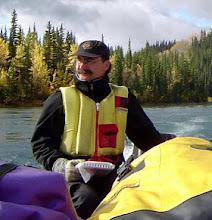 |
| Stuart's son hydraulics the side of the creek, thawing and washing away the barren (no gold present) muck and exposing other buried treasure. |
Late this summer I joined Joy and her boss, Elaine, the Yukon Minister for Tourism and Culture on a visit to Stuart Schmidt's placer gold mine on Quartz Creek in the Klondike gold fields. The Schmidt family has been mining gold for several generations and Stuart has come into my history class at the College to talk about his family's life as gold miners. Today however we are not looking for gold but for bones.
 |
| Grant (centre) with his graduate students, Tyler Kuhn and Elizabeth, and Joy pull on their rubber boots. |
Grant Zazula is the Yukon Palaeontologist. He is responsible for the study of extinct and fossilized animals and plants in the territory. And the Yukon is rich in these remains since Beringia (check out http://www.beringia.com/ for the Whitehorse interpretive centre), the northern and central portions of the Yukon, was not recently glaciated. That is, the bones are still lying around, they haven't been scraped into dust under mile deep sheets of moving ice. They are however buried in the frozen soils and it is no easy matter to find them. Palaeontology research often does excavations, but they are expensive and offer limited access to the scatter of ancient bones.
 |
| Stuart and Elaine (L) head up the creek with Grant to look for bones. |
Happily in the Yukon we have an industry that does massive excavation of soils and very carefully sifts through it looking for gold. And they also find the fossil bones and other traces of the Yukon landscape of ten thousand years and more ago. For decades there has been a beneficial partnership between government and museum palaeontologists and placer miners in the Klondike. A recent on-line publication tells the full story.
 |
| Elizabeth show me how easy it is to find the bones. This one comes from a bison or maybe it was a camel. Eventually I trip over a bone and also "find" it. |
As we walk up the creek we are literally stumbling over the remains of a remarkable array of animals that used to live in the Yukon. Mammoth teeth, bison skulls with their horns, shin bones from camels and even parts of the little horses that used to run amongst the herds of other animals.
 |
| Stuart picks up the pieces he finds while he's working and sets them aside for the visits by Tyler and Elizabeth. |
Tyler and Elizabeth have been hired for the summer mining season to visit co-operating placer miners and collect the bones for further research. Grant is certain that having friendly, young professionals working with the miners is the best way to grow the collections of these important items and expand our knowledge of the Beringian past. And he's happy to have a chance to showcase this to the Minister, who also comes from a placer mining family. Elaine is on familiar ground and is impressed with the team's work.
Once we reach the upper end of the work on the creek we've amassed quite a collection of bones. Stuart and his son get back to their work of preparing the creek for mining operations and we pick up heavy bags full of fossilized bones and other treasures. Many palaeontology digs are happy to find a dozen bones in a season's work. In four hours of poking around we've collected over a hundred kilos of research material. Now we have to lug the bags and pails on the long hike back to the truck. Certainly the collaboration between palaeontology studies and placer mining is worthwhile and productive.


e.jpg)
.JPG)






No comments:
Post a Comment